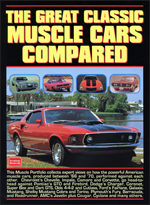Úvod »* Kalendáře» Mercury Comet & Cyclone 1960-1975
Anotace
The American automobile industry did not do small cars, it was ingrained in its psyche that bigger was better. Sure enough, the Lincoln-Mercury Division of Ford announced the Mercury Comet just four months after the Falcon! Without being too unkind to the Comet, it was a Falcon with a longer wheelbase (all aft of the back seat), a stretched rear end and ugly slanted tail-lights and not much else. Mechanically practically everything was interchangeable. However, there were bigger plans afoot as soon became apparent a year later when the Comet S-22 V8 was announced as a 19631/2 model. Boasting the 260-cid V8 engine, 164 bhp, 4-speed manual gearbox and 10-inch drum(!) brakes all round, it was quite a performance machine for the time. It zipped from 0-60 mph in 11.5 seconds and would run to 94 mph. Stopping it was always an interesting experience. In the context of what was happening in the US automobile industry at the time, the progression from compact to super-compact to mid-sized was inexorable; it was a time when too much of a good thing was still not enough! It was not long before the Lincoln-Mercury Division was fielding ever-larger compacts that could trace their lineage back to the Falcon and original Comet. By 1964 there was the Comet Cyclone with an even larger 289-cid V8 and in the following year a complete redesign also brought more sheet metal and the added option of a massive 390-cid V8 engine. Would you believe that disc front brakes were an option, even with the biggest engine? Shows how times were then. By 1967 it was no longer a compact but a proper mid-sized car line that was a Mercury first, Comet second. It went head-to-head with the Pontiac Le Mans chasing the sports sedan buyer in the US market. By 1968 there was the Cyclone GT fastback coupe that was considered by Ford enthusiasts as the epitome of style and performance—the top of the line model could be equipped with every conceivable luxury item and the 355 bhp 428-cid V8 engine. Top speed was only 117 mph but the 0-60 sprint took just 6.0 seconds, very good for a 4000 lb coupe in 1968. There was a model hiatus in 1970, the Comet name returning in 1971 as a rebadged Maverick, deja vu. By now the excitement in the model had gone and it was little more than a price-leader for the Mercury range. As the decade passed the inevitable growth of the lineup meant that within five years the roots of the model had vanished as the marketeers took over and expanded the range to market segments never before seen as Lincoln-Mercury territory. In the ever-changing world of the automobile nothing stands still for fear of being overtaken by so-called progress. And that is what happened to the Comet—it lost its identity and was soon a spent force within the Ford Motor Company. This portfolio encapsulates the first decade & a half of the Comet & Cyclone, one of the auto industry's responses to the compact car phenomenon. Included are road & comparison tests, new model reports & full performance data.
Models covered: Comet, S-22, GT & Caliente & the Cyclone, GT, Cobra Jet & Montego. A total of 128 pages.





























